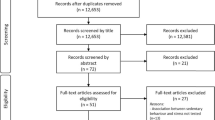Abstract
Background
Emerging evidence suggests that sedentary behaviour may be adversely associated with physical health, but few studies have examined the association with mental well-being.
Purpose
This study examined the association of four non-occupational sedentary behaviours, individually and in total, with mental well-being in employed adults.
Methods
Baseline data from the evaluation of Well@Work, a national workplace health promotion project conducted in the UK, were used. Participants self-reported sitting time whilst watching television, using a computer, socialising and travelling by motorised transport. Mental well-being was assessed by the 12-item version of the general health questionnaire. Analyses were conducted using multiple linear regression.
Results
In models adjusted for multiple confounders, TV viewing, computer use and total non-occupational sitting time were adversely associated with general health questionnaire-12 assessed mental well-being in women. Computer use only was found to be adversely associated with mental well-being in men.
Conclusion
Sedentary behaviour may be adversely associated with mental well-being in employed adults. The association may be moderated by gender.
Similar content being viewed by others
References
Morris JN, Heady JA, Raffle PAB, et al. Coronary heart-disease and physical activity of work. Lancet. 1953; 265: 1111–1120.
Owen N, Leslie E, Salmon J, et al. Environmental determinants of physical activity and sedentary behavior. Exerc Sport Sci Rev. 2000; 28(4): 153–158.
Owen N, Healy GN, Matthews CE, et al. Too much sitting: The population health science of sedentary behavior. Exerc Sport Sci Rev. 2010; 38(3): 105–113.
Marshall SJ, Ramirez E. Reducing sedentary behavior: A new paradigm in physical activity promotion. Am J Lifestyle Med. 2011; doi: 10.1177/1559827610395487.
Tremblay MS, Colley RC, Saunders TJ, et al. Physiological and health implications of a sedentary lifestyle. Appl Physiol Nutr Metab. 2010; 35(6): 725–740.
Dunstan DW, Salmon J, Healy GN, et al. Association of television viewing with fasting and 2-h postchallenge plasma glucose levels in adults without diagnosed diabetes. Diabetes Care. 2007; 30(3): 516–522.
Dunstan DW, Barr EL, Healy GN, et al. Television viewing time and mortality: The Australian Diabetes, Obesity and Lifestyle Study (AusDiab). Circulation. 2010; 121(3): 384–391.
Katzmarzyk PT, Church TS, Craig CL, et al. Sitting time and mortality from all causes, cardiovascular disease, and cancer. Med Sci Sports Exerc. 2009; 41(5): 998–1005.
Prince M, Patel V, Saxena S, et al. No health without mental health. Lancet. 2007; 370(9590): 859–877.
Mathers CD, Loncar D. Projections of global mortality and burden of disease from 2002 to 2030. PLoS Med. 2006; 3(11): e442.
Biddle SJH, Fox KR, Boutcher S. Physical activity and psychological well-being. London: Routledge, 2000.
Healy GN, Dunstan DW, Salmon J, et al. Objectively measured light-intensity physical activity is independently associated with 2-h plasma glucose. Diab Care. 2007; 30(6): 1384–1389.
Katzmarzyk PT. Physical activity, sedentary behavior, and health: Paradigm paralysis or paradigm shift? Diabetes. 2010; 59(11): 2717–2725.
Teychenne M, Ball K, Salmon J. Sedentary behavior and depression among adults: A review. Int J Behav Med. 2010; 17(4): 246–254.
Hamer M, Stamatakis E, Mishra GD. Television- and screen-based activity and mental well-being in adults. Am J Prev Med. 2010; 38(4): 375–380.
Goldberg DP, Gater R, Sartorius N, et al. The validity of two versions of the GHQ in the WHO study of mental illness in general health care. Psychol Med. 1997; 27(1): 191–197.
Teychenne M, Ball K, Salmon J. Physical activity, sedentary behavior and depression among disadvantaged women. Health Educ Res. 2010; 25(4): 632–644.
Kraut R, Kiesler S, Boneva B, et al. Internet paradox revisited. J Soc Issues. 2002; 58: 49–74.
Kraut R, Patterson M, Lundmark V, et al. Internet paradox. A social technology that reduces social involvement and psychological well-being? Am Psychol. 1998; 53(9): 1017–1031.
Bull FC, Adams EJ, Hooper PL. Well@Work: Promoting active and healthy workplaces final evaluation report. School of Sport and Exercise Sciences, Loughborough University. http://www.bhfactive.org.uk/homepage-resources-and-publications-item/102/index.html; 2008. Accessed 20 Jan 2011
Craig CL, Marshall AL, Sjostrom M, et al. International physical activity questionnaire: 12-country reliability and validity. Med Sci Sports Exerc. 2003; 35(8): 1381–1395.
Wareham NJ, Jakes RW, Rennie KL, et al. Validity and repeatability of the EPIC-Norfolk Physical Activity Questionnaire. Int J Epidemiol. 2002; 31(1): 168–174.
Sanchez-Villegas A, Ara I, Guillen-Grima F, et al. Physical activity, sedentary index, and mental disorders in the SUN Cohort Study. Med Sci Sports Exerc. 2008; 40(5): 827–834.
Marshall SJ, Biddle SJ, Gorely T, et al. Relationships between media use, body fatness and physical activity in children and youth: A meta-analysis. Int J Obes Relat Metab Disord. 2004; 28(10): 1238–1246.
Hamer M, Stamatakis E, Steptoe A. Dose-response relationship between physical activity and mental health: The Scottish Health Survey. Br J Sports Med. 2009; 43(14): 1111–1114.
Acknowledgements
The Well@Work evaluation project was funded by Department of Health, Sport England, BIG Lottery and British Heart Foundation.
Conflict of Interest Statement
The authors have no relevant conflicts of interest to disclose.
Author information
Authors and Affiliations
Corresponding author
About this article
Cite this article
Atkin, A.J., Adams, E., Bull, F.C. et al. Non-Occupational Sitting and Mental Well-Being in Employed Adults. ann. behav. med. 43, 181–188 (2012). https://doi.org/10.1007/s12160-011-9320-y
Published:
Issue Date:
DOI: https://doi.org/10.1007/s12160-011-9320-y



